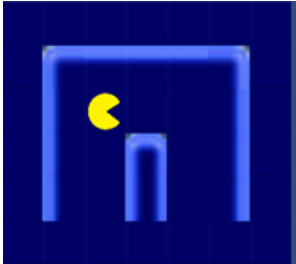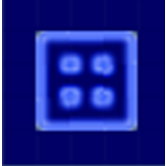Game Concept
Game Concept Devlog
Working Title
Ultimate Pacman
Concept Statement
In Ultimate Pacman the player, Pacman, in each level navigates through a maze to collect all of the coins that were stolen from them by the evil ghosts. In each level they will have to collect various power-ups distributed throughout the level in order to assist them to avoid and defeat the ghosts that are out to get them at every stage.
Genre
The genre of this game is action, adventure and maze. It is an action game because the player, Pacman, has to constantly move around the level, avoiding enemies and collecting power-ups and coins. This makes it an action game because it incorporates a physical challenge of reaction times in relation to avoiding the enemies, and problem solving in planning out how to avoid the enemies and collect all of the coins in the level. It is also an action game because the player is able to be hurt by the enemies and they die when they run out of lives, a common theme in action games.
It is an adventure game because the player assumes the role of the protagonist, Pacman, in a story where they have to collect all of their lost coins and reclaim their wealth from the ghosts that stole it. This makes it an adventure game because the player is following the adventure of the character Pacman. It is a maze game because the entire playing field of each level is a maze.
Concept Creation Process/area and Influences
The process of concept creation for this game started with identifying a game that was well liked and could be expanded. This then led to Pacman being chosen as the basis and the main influence for this game. The influence of Pacman (Iwatani, 1980) can be seen in the general movement and gameplay and in the style of the levels. It can also be seen in the characters used both the player, Pacman, and the enemies, the ghosts. After a game was chosen as a starting point ways to implement the main features of Pacman such as the movement, setting and enemies were identified. This was then evaluated to determine if this was a reasonable undertaking which it was determined to be. After a way to implement the basic features of Pacman was developed, ways to expand on it and add new features were constructed. These included having different designs for each level where originally Pacman has the same layout for each level, adding variety to the enemies and what they are able to do rather than the enemies being the same in each level, and adding additional power-ups including weaponry for Pacman to shoot back at the newly developed ghosts rather than the only consumable being the cherries. After these extensions were conceived ways to implement them were identified. Once all the elements of the game had been thought of and ways of implementing them considered, a final product of how the game would look when completed was designed. This was identified to be Pacman navigating a maze while ghosts chase after them, collecting power-ups to defeat the ghosts and enable them to collect all the coins. Once how the game would function was designed the UI elements were considered and how they were to be implemented was examined. Once this had been finalised a concept for Ultimate Pacman had been developed that was ready to start implementing.
Audience and Competitive Analysis
The target audience for this game is everyone, male and female, young and old alike. Younger groups of people would be interested in the game concept because the controls and the aim of the game are simple so they are able to follow the game easily and hence continue to be engaged and entertained by it. Older groups of people would be interested in this game as well for similar reasons. Both of these groups of people would also be interested because the game is bright and colourful through the brightly coloured ghosts, Pacman, and power-ups. This makes it engaging to look at and this then leads to these people becoming hooked on the game. Males would be interested in the game concept because the gameplay is fast paced so there is constant action, and there are also various power-ups that will engross them in learning how best to use them to vanquish the ghosts and reclaim the stolen loot. Females would be interested in the game concept because to win the game there is lots of problem solving that must occur to collect all the coins whilst avoiding all the ghosts. Another reason is that they would be compelled to feel compassion for the character Pacman as they have had their coins stolen and is on a quest to reclaim them. This would absorb them in making sure that Pacman is able to fulfil his quest. The main target audience of this game concept is also casual players. This is because the gameplay is suited to a lighter more fun oriented style of play rather than extremely completion and achievement driven.
The competition this game concept will face is in similar maze games such as the original Pacman. This is because they have similar controls and gameplay. These games have performed well and been very popular with a large variety of groups of people. The unique selling points of this game concept over the others is that it contains a variety of enemies and power-ups which are not present in any of the competition games. This will make this game concept stand out and above the competition due to these different and appealing additions.
Game Treatment and Concept Art
You are Pacman, and you are on a quest to reclaim your lost fortune of coins from the ghosts that stole it from you. To do this you must navigate every maze level and collect all the coins from around the maze. You must do this while avoiding the ghost army that will be an ever-present threat in each level and will try and stop you from accomplishing your goal at every stage. The setting for your quest is Pac-Land (Kishimoto, 1984). This is a land of great conflict between the peaceful race of Pacmen and the evil race of ghosts whose only goal is to steal all of the Pacmen’s coins. To assist you on your quest your fellow Pacmen have left various power-ups along your path to help you in your journey to reclaim your wealth and score a sizable victory for the Pacmen against the ghosts. These power-ups will give you abilities such as the ability to shoot at the ghosts, and the ability to move faster than you ever thought possible just to name a few. You may even have some power-ups that will give you abilities that Pacmen before you would have only dreamt of. To stop you the ghosts have themselves got some new weaponry that they will use to stop you in your tracks. If you run out of lives, your quest will be at an end and the ghosts will have scored a major victory in the battle between Pacmen and ghosts. As each level progresses the ghosts will become more difficult to defeat.
The key features of this game are the level layout which takes the form of a maze and is different in each level, the power-ups which will change frequency and effect as the levels progress, the story which illustrates the premise of the game and the reason for the player’s character to be going through this journey, and the enemies which are the ghosts and will gather different and more powerful abilities as the player advances through the levels.
The key mechanics of this game are that the player will use either the arrow keys or wasd to move Pacman through the levels. This will occur by each key setting the player’s character moving in that direction. Pacman will never stop moving during the levels so the player will be always involved in navigating the levels. The player will also use their collected power-ups throughout the level with different keys that will be communicated in game. These will include the space bar to shoot and the m key to use super speed. The player will also have the option of customising features of the game such as their character’s colour.
The art style of the game is illustrated in the following concept art images.

(Standard outline of each level tiles)

(Standard central tiles)
These images show the general concept art of the game. The template for the tilemap that has been created was obtained from: (Cloning the Classics: Pacman, 2012). The Pacman sprite was obtained from: (Game Development, 2020). The art style was designed to be simple while still being interesting and colourful, just like the original Pacman game. The cover picture was obtained from here: (8 Things You Didn’t Know About Pac-Man, 2020).
References
Code Avengers. 2020. Game Development. [online] Available at: https://www.codeavengers.com/teacher/game#6.2 [Accessed 27 August 2020].
Construct Tutorials. 2012. Cloning the Classics: Pacman. [online] Available at: https://www.construct.net/en/tutorials/cloning-classics-pacman-171 [Accessed 28 August 2020].
Found Item Clothing. 2020. 8 Things You Didn’t Know About Pac-Man. [online] Available at: https://www.founditemclothing.com/blogs/it-goes-to-11/8-things-you-didn-t-know-about-pac-man [Accessed 28 August 2020].
Iwatani, T., 1980. Pacman. [online] Bandai Namco. Available at: https://en.bandainamcoent.eu/ [Accessed 27 August 2020].
Kishimoto, Y., 1984. Pac-Land. [online] Bandai Namco. Available at: https://en.bandainamcoent.eu/ [Accessed 28 August 2020].
Ultimate Pacman
| Status | Prototype |
| Author | JoshuaPerrin |
More posts
- Documentation + User GuideOct 16, 2020
- Testing (Assingnment 5 Devlog)Oct 09, 2020
- Game TestingOct 05, 2020
- UI and PolishOct 02, 2020
- Presentation and GraphicsSep 25, 2020
- Enemies/InteractionsSep 18, 2020
- Basic Level BlockingSep 11, 2020
- Player MovementAug 28, 2020
Leave a comment
Log in with itch.io to leave a comment.